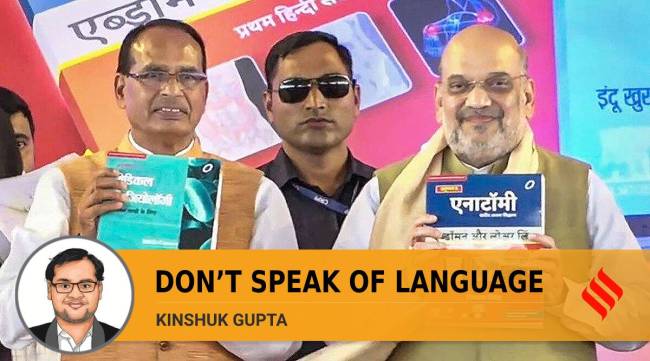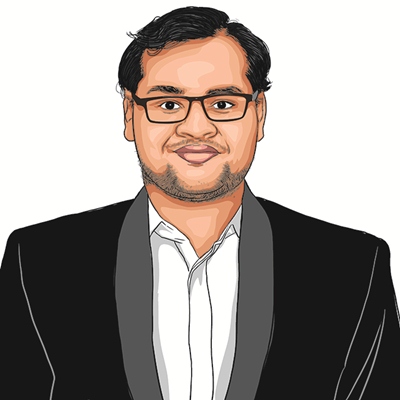Opinion A medical student writes: What the language debate misses, and why translating MBBS books to Hindi is easier said than done
Medicine is constantly evolving with the introduction of novel research. Treating cases sometimes requires consulting multiple books, research papers, and journal articles, for which a sound system of translation needs to be established before we can even begin thinking about phasing out English
 There has been no clarity on whether or how these translations will be incorporated as reading materials, and how they will evolve or change with time.(PTI)
There has been no clarity on whether or how these translations will be incorporated as reading materials, and how they will evolve or change with time.(PTI) Transitioning from a Hindi-medium government school in Jhalawar to the University College of Medical Science in New Delhi was an uphill task for Dr Sanjay Patidar. Never did the village boy — he aced the AIPMT exam with an All India Rank of 93 — think that his career would be dictated by his lack of command over English. He would confuse words such as “course” and “coarse”; “wrap” and “rape”. So, when his professors asked him about the course of the radial nerve, or what wraps around the axon, all he could do was look at them blankly, he told me.
My batchmate from college would cut down on his sleep to binge-watch Hollywood films or web series to pick up new English words. He would then watch them again with subtitles to learn the meanings of those words. Even when he knew the answer to a question, he would never dare utter it for the fear of being laughed at. Both of them were pleased with the government’s decision to introduce Hindi as the medium of instruction instead of English in central institutions for higher education.
The unveiling of the Hindi editions of the first professional MBBS books by Union Home Minister Amit Shah in Bhopal has, however, stirred anti-Hindi agitations, with the Opposition, especially in the South, contending that the move is nothing more than a poll gimmick. For many in the medical fraternity, still reeling under the anxiety of another similar, abrupt announcement — the shift of the exam pattern from NEET to NeXt — the decision is unwelcome.
Supporters of the move are quoting examples from China, Japan, Ukraine, Russia, and Norway – countries where official languages are the sole medium of instruction in all the technical and non-technical courses. If they can do so, why can’t we, they argue, especially as it is an established fact that imparting education in a student’s mother tongue is effective for learning. It would be a sure-shot path to India being a superpower, so what’s stopping us? The fact of the matter is: These arguments might steer sentiments, but they are over-simplistic ways to look at a complex problem.
For one, these “facts” are not entirely true. Fifty-two medical colleges, out of the total 170 colleges on mainland China, whose graduates can attempt the USMLE (the entrance exam to practice in the US), teach in both Chinese and English. There has been a steep rise in the number of parents interested in enrolling their children – at just three years old – in ESL (English as a Second Language) courses .
It is unwise to compare the status of Hindi to Chinese or German, given India’s diversity. Moreover, Hindi, or any other vernacular language, for that matter, offers far fewer resources to support the job-seeking young populace. Learning English, therefore, comes with a promise of roti, kapda, makaan (food, clothes, shelter.) A few years ago, when newspapers reported on the closing down of government schools in Tamil Nadu, one of the major reasons cited was parents’ preoccupation with English-medium schools – leading them to deny free cash and food and admit their kids to low-end, mediocre English schools, instead.
When it comes to higher education, English is a great leveller, allowing dialogue to continue with the rest of the world. Medicine, as evidence-based as it is, is constantly evolving with the introduction of novel research. Treating cases sometimes requires consulting multiple books, research papers, and journal articles, for which a sound system of translation needs to be established before we can even begin thinking about phasing out English.
The people involved in the translation process spoke of two things while talking to me. First, instead of “translation”, the books have been transliterated. The medical terminology remains the same; sentences have only been translated for easier reading. That too, in the most mainstream dialect of Hindi. Second, these books are to be used as “bridge books”, and not as replacements for the English ones, designed to address the initial hiccups students are bound to face.
Flipping through the pages of Vishram Singh’s Anatomy: Upper Limb and Thorax, I found no significant difference between the original and transliterated texts. Instead, in some sections, the paragraphs ended up becoming much denser with the English names of the subject at hand in brackets. The transliteration is also subpar; the book reads like a cheap-quality guide.
The initial announcement also fails to account for the necessary infrastructure. There has been no clarity on whether or how these translations will be incorporated as reading materials, and how they will evolve or change with time. Whether standard books like Harrison and Robbins would also be translated is anyone’s guess. Translating these tomes only once would not suffice as newer editions every three to five years incorporate significant changes. Professors and other teaching staff would also need to be trained. Most of all, what about medical conferences, the staple of a medical student? Would they be organised in Hindi moving forward?
The announcement seems to address only the tail, not the whole elephant. Offering extra evening classes as done by AIIMS, Delhi could have been a better substitute given that the strength of students who struggle with English makes up about one to two per cent of the entire batch. Besides, no strict distinction exists between Hindi and non-Hindi-speaking states as most institutions have a portion of seats that are filled up by a pan-India entrance exam. How can we, then, assume that a student from Tamil Nadu in AIIMS, Delhi, would not want to study in Tamil?
While basing our argument only on language, we often forget that Chinese healthcare is self-sufficient when it comes to research and protocols, or that Germany has primary resources available in their own language. Our focus right now should be to develop primary resources. Our medical industry is at way too nascent a stage to be speaking of language.
The writer is a medical student and writer




